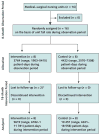Effects of an intervention to increase bed alarm use to prevent falls in hospitalized patients: a cluster randomized trial
- PMID: 23165660
- PMCID: PMC3549269
- DOI: 10.7326/0003-4819-157-10-201211200-00005
Effects of an intervention to increase bed alarm use to prevent falls in hospitalized patients: a cluster randomized trial
Abstract
Background: Bed alarm systems intended to prevent hospital falls have not been formally evaluated.
Objective: To investigate whether an intervention aimed at increasing bed alarm use decreases hospital falls and related events.
Design: Pair-matched, cluster randomized trial over 18 months. Nursing units were allocated by computer-generated randomization on the basis of baseline fall rates. Patients and outcome assessors were blinded to unit assignment; outcome assessors may have become unblinded. (ClinicalTrials.gov registration number: NCT00183053)
Setting: 16 nursing units in an urban community hospital.
Patients: 27 672 inpatients in general medical, surgical, and specialty units.
Intervention: Education, training, and technical support to promote use of a standard bed alarm system (intervention units); bed alarms available but not formally promoted or supported (control units).
Measurements: Pre-post difference in change in falls per 1000 patient-days (primary end point); number of patients who fell, fall-related injuries, and number of patients restrained (secondary end points).
Results: Prevalence of alarm use was 64.41 days per 1000 patient-days on intervention units and 1.79 days per 1000 patient-days on control units (P = 0.004). There was no difference in change in fall rates per 1000 patient-days (risk ratio, 1.09 [95% CI, 0.85 to 1.53]; difference, 0.41 [CI, -1.05 to 2.47], which corresponds to a greater difference in falls in control vs. intervention units) or in the number of patients who fell, injurious fall rates, or the number of patients physically restrained on intervention units compared with control units.
Limitation: The study was conducted at a single site and was slightly underpowered compared with the initial design.
Conclusion: An intervention designed to increase bed alarm use in an urban hospital increased alarm use but had no statistically or clinically significant effect on fall-related events or physical restraint use.
Primary funding source: National Institute on Aging.
Conflict of interest statement
Figures


References
-
- Oliver D, Healey F, Haines TP. Preventing falls and fall-related injuries in hospitals. Clin Geriatr Med. 2010;26:645–92. - PubMed
-
- Cameron ID, Murray GR, Gillespie LD, Robertson MC, Hill KD, Cumming RG, et al. Interventions for preventing falls in older people in nursing care facilities and hospitals. Cochrane Database Syst Rev. 2010:CD005465. - PubMed
-
- Morse JM. Enhancing the safety of hospitalization by reducing patient falls. Am J Infect Control. 2002;30:376–80. - PubMed
-
- Rubenstein LZ, Josephson KR. The epidemiology of falls and syncope. Clin Geriatr Med. 2002;18:141–58. - PubMed
-
- Agostini JV, Baker DI, Bogardus ST. Making Health Care Safer: A Critical Analysis of Patient Safety Practices. File Inventory, Evidence Report/Technology Assessment no. 43. AHRQ publication no. 01-E058. Rockville, MD: Agency for Healthcare Research and Quality; 2001. [25 September 2012]. Chapter 26. Prevention of falls in hospitalized and institutionalized older people; pp. 281–99. Accessed at www.ahrq.gov/clinic/ptsafety/chap26a.htm on.
Publication types
MeSH terms
Associated data
Grants and funding
LinkOut - more resources
Full Text Sources
Medical
